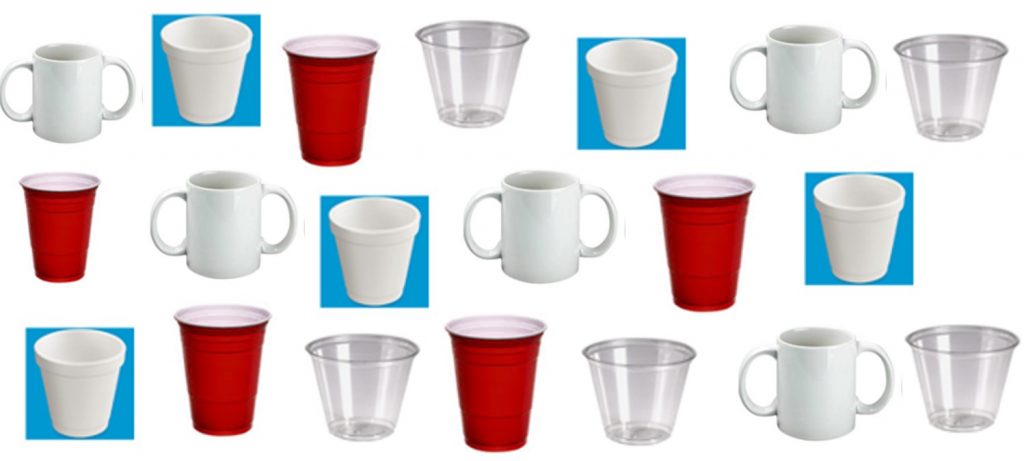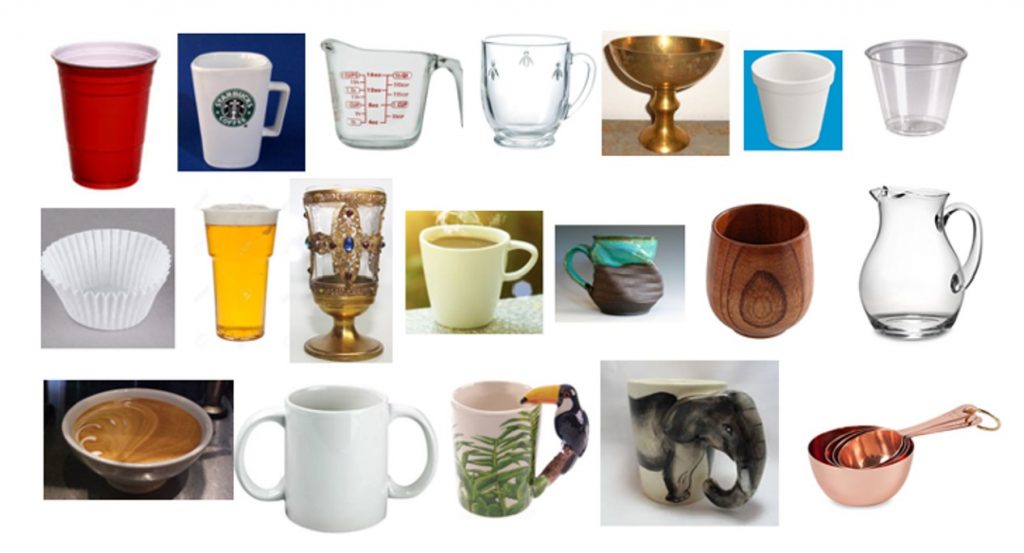43 Activity – Scope and Scale

You probably feel that organizing this collection would be easy, but why do you feel this way? It comes back to the fundamental secret of organizing…. that WHY you organize and HOW you organize are interconnected decisions. Why would you organize a collection of containers for liquids like these? The best answer would be something like “so it is easy to select an appropriate container for different types of liquids.” Given that reason, the most appropriate properties would be something like these:

- Material that the container is made of
- The color of the container
- Whether or not the container has handles
If you organize the containers using these three properties, it will be easy to select the appropriate container. Mission Accomplished!

You probably feel a little overwhelmed by the variety of items here. You could try to organize them using the material, color, and handle properties that you saw in the other collection of “containers for liquids” but many more properties suggest themselves in the second collection to organize the items. What about:
- Does the container have a brand name on it
- Could it be used for measuring
- Is it handmade
- Does it have a decorative handle
- Does it have more than one handle
- Does the handle look like an animal
- AND YOU COULD PROBABLY THINK OF EVEN MORE!
Remember the connection between WHY and HOW in organizing! The more ways in which you want to select one of these items, the more properties you will need to use to organize them, and you’ll have a very complex taxonomy to design and use.
But you might also remember the “Santa” question. That question asks you to decide whether to think of something as a unique resource or as a member of a bigger category in which all of the resources are considered to be equivalent. They aren’t identical. but we can decide to ignore the properties that would distinguish them. So you could make this organizing problem very easy by putting all of these items in a “containers for liquids” cabinet! You would have to search the cabinet if you were looking for a specific item, but that would be easier than designing and maintaining a very complex organizing system.
ACTIVITY: Find the “cattle ranches” and “zoos” in your house.
When you learned about how SCOPE and SCALE affect the design of an organizing system, we compared a cattle ranch with a zoo. The cattle ranch has small SCOPE and big SCALE because it has many instances of the same type of thing. The zoo has big SCOPE and not so big SCALE because it has lots of different types of things but not many of each type.
- Analyze the organizing systems in the kitchen. What kinds of things are organized like the cattle ranch (where there are many instances of the same type of thing), and which kinds of things are organized like the zoo (where there are many types of things, but not many of each type)?
- Do the same thing for your clothes. What are the cattle, and what is the zoo?
- Could you turn the zoo into a cattle ranch to make it easier to organize by treating things as equivalent even though they have some different properties?
ANSWERS (don’t look until you’ve done the activities):
-
- The drawer for utensils is like a cattle ranch — there are many forks, knives, and spoons that are treated as equivalent; you can use any one of them. The pantry where you keep spices and condiments is like a zoo — there are lots of different things, and probably only one of each type of thing
- Most people have a bunch of underwear and t-shirts that they treat as equivalent and are kept in the same drawer or on the same shelf — they are cattle ranches. You just grab one of each in the morning when you get dressed. But the clothes you wear when you dress up for a special event are just that – special. So you manage those clothes like a zoo.
- Some people sort their socks very carefully, separating them by color, by material (cotton, wool, nylon, etc.), and by activity — they have a zoo for socks. But if you don’t want to work so hard at organizing socks, you can just toss them unsorted in a sock drawer and then search for two that match when you need to wear socks — you turned your sock zoo into a sock cattle ranch.

